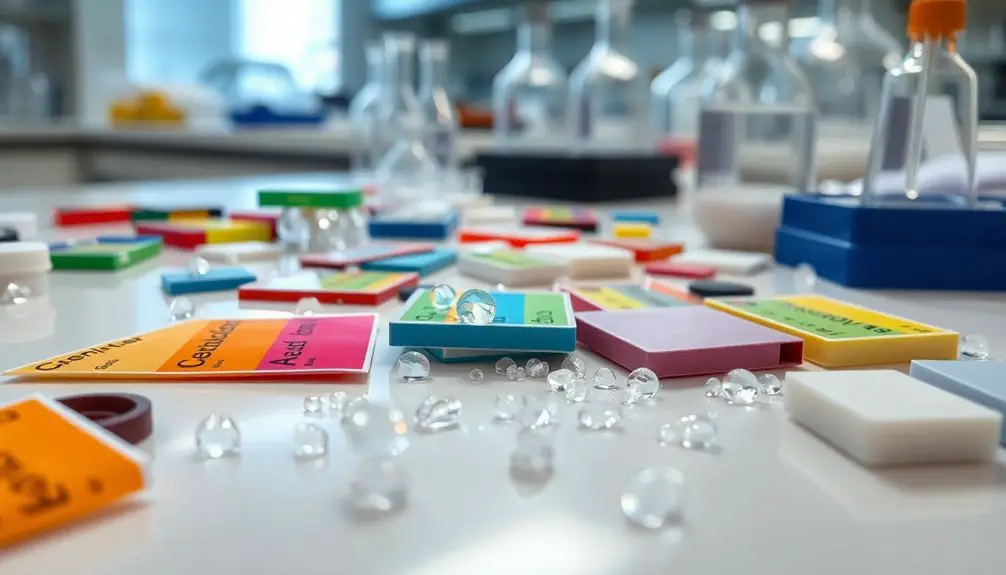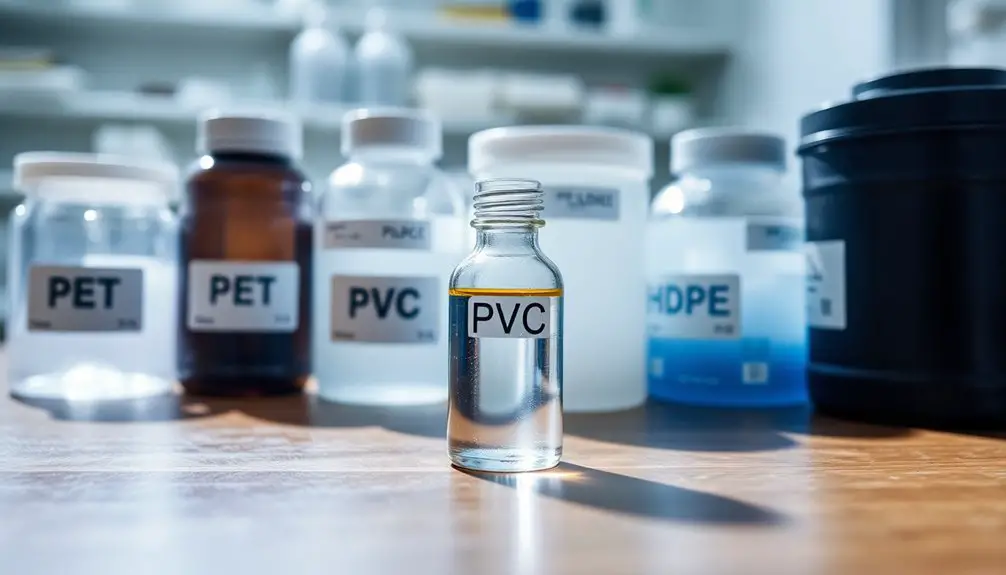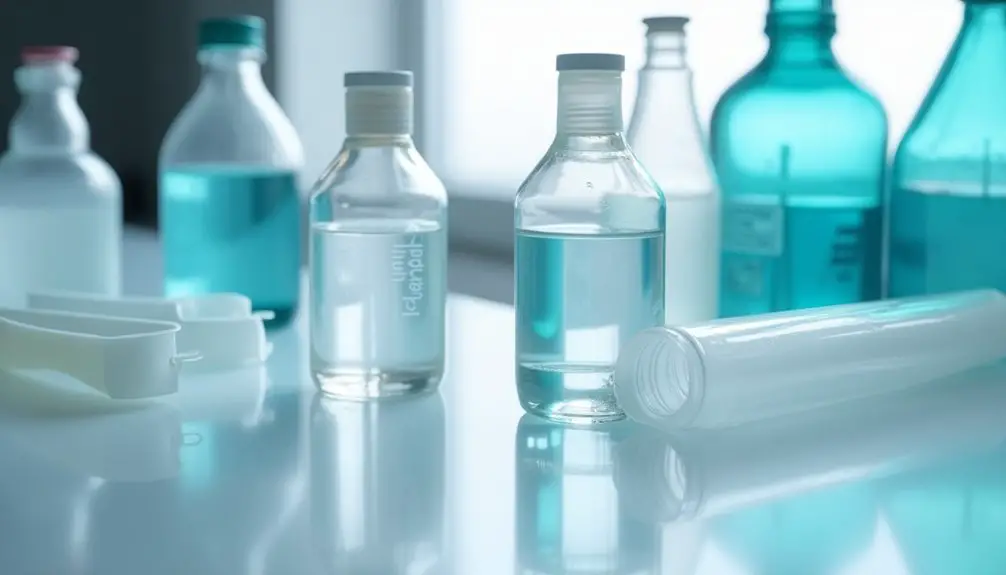Isopropyl alcohol can damage some plastics, so it's essential to know their compatibility. For example, polyethylene and polypropylene are generally compatible but might show haze when used. PVC can handle lower concentrations, while more resilient plastics like PVDF and PTFE show excellent resistance. It's wise to dilute the alcohol to minimize any potential damage. Always test in actual conditions to ensure safety and maintain material integrity. If you want to learn more about which plastics are best suited for Isopropyl alcohol and how to use it safely, keep exploring for additional insights.
Key Takeaways
- Isopropyl Alcohol (IPA) generally shows good compatibility with plastics, but effects vary by type and concentration.
- Polyethylene and polypropylene may leave a residue haze; dilution with water is recommended for cleaning.
- PVC is suitable for lower concentrations of IPA, though glossy surfaces may exhibit haze.
- PVDF and PTFE have high resistance to IPA, ensuring effective cleaning with minimal residue retention.
- Testing in actual conditions is advisable to assess chemical compatibility and prevent potential damage.
Isopropyl Alcohol Overview
Isopropyl alcohol (IPA) is a clear, colorless liquid known for its strong, pungent odor and versatile applications. Its chemical formula is C3H8O, with a molecular weight of 60.0950 g/mol.
You'll find that it boils at 82.5 °C and freezes at −89 °C, making it a useful solvent in various conditions. IPA is miscible in water, ethanol, and chloroform, but it doesn't mix well with salt solutions.
Primarily produced through hydration reactions involving water and propene or by hydrogenating acetone, the global market for IPA was approximately 2.3 million tonnes in 2022, with growth expected to reach around 2.9 million tonnes by 2030.
In industrial settings, IPA serves as a solvent for gums, resins, and quick-drying inks. You also encounter it in medical applications like rubbing alcohol and hand sanitizers. Additionally, its ability to evaporate quickly makes it suitable for cleaning applications where minimal residue is desired.
While IPA is somewhat more toxic than ethanol, it's less toxic than ethylene glycol or methanol.
Always exercise caution when handling it due to its flammability and potential reactions with acids and strong oxidizing agents.
Effects on Different Plastics
When it comes to using isopropyl alcohol, understanding its effects on various plastics is crucial for ensuring compatibility and maintaining the integrity of materials.
Here's a quick overview of how isopropyl alcohol interacts with different plastics:
- Polyethylene: Generally well-tolerated, but can leave a residue haze, especially on shiny surfaces. Diluting with water can help reduce this effect. Isopropyl alcohol is effective in eliminating 99.99% of germs in 10-30 seconds, making it a popular choice for cleaning.
- Polypropylene: Similar to polyethylene, it shows good compatibility but may also develop a haze. Again, diluting isopropyl alcohol is a smart move.
- PVC (Polyvinyl Chloride): Suitable for lower concentrations of isopropyl alcohol, but watch out for the haze on glossy surfaces. Dilution remains an effective cleaning method. The chemical resistance of plastics, including material properties, is essential to consider when choosing the right material for a specific application.
On the other hand, PVDF (Polyvinylidene Fluoride) and PTFE (Polytetrafluoroethylene) stand out with their high resistance to isopropyl alcohol.
They're less likely to retain any residue and can be cleaned effectively without issues.
Understanding these interactions will help you choose the right plastic for your needs, ensuring longevity and optimal performance.
Chemical Resistance Ratings

Understanding how different plastics respond to isopropyl alcohol sets the stage for exploring chemical resistance ratings. These ratings are crucial for determining how well a plastic will withstand exposure to isopropyl alcohol and other chemicals.
Typically, you'll encounter rating systems like A (Excellent – No effect), B (Good – Minor effect), C (Fair – Moderate effect), D (Severe effect – Not recommended), and U (Unsatisfactory).
It's essential to recognize that a plastic's resistance varies by material type, such as HDPE properties, which can affect its compatibility with isopropyl alcohol. Isopropyl alcohol generally shows good compatibility with most plastics, though some may experience minor effects, such as discoloration. The resistance is affected by factors such as temperature and chemical concentration, so testing under actual operating conditions is essential.
Chemical compatibility charts are valuable tools that help you select the right plastic for specific chemical exposures. They provide detailed insights into how different plastics behave with isopropyl alcohol and other substances.
While these charts are informative, remember they serve as general guides. For definitive results, conducting initial and long-term testing is recommended to ensure material suitability for your specific applications.
Safe Usage Guidelines
To ensure safe handling and usage of isopropyl alcohol, follow some essential guidelines. Proper handling can help you avoid accidents and maintain a safe environment.
- Ventilation: Always use isopropyl alcohol in a well-ventilated area. This minimizes inhalation of harmful fumes and keeps the air fresh.
- Storage: Store isopropyl alcohol in tightly closed containers, away from heat and open flames. Choose a cool, dry place to prevent any hazards. Additionally, remember that higher concentrations of isopropyl alcohol are more flammable, so extra caution is necessary.
- Cleaning Method: When cleaning surfaces, dilute isopropyl alcohol with water to reduce its solvent power. Use a cloth dampened with the solution, and quickly wipe off any excess liquid to prevent residue.
Health and Safety Precautions

Health and safety are paramount when working with isopropyl alcohol, as improper handling can lead to serious consequences. Inhaling vapors can irritate your nose and throat, causing coughing and wheezing. Stick to OSHA's limit of 400 ppm over an 8-hour work shift to avoid headaches, dizziness, and more severe health effects. Repeated exposure could even pose long-term risks, including cancer hazards.
When it comes to skin contact, you should avoid it altogether. Isopropyl alcohol can cause irritation, burns, and rashes. Always wear appropriate personal protective equipment, such as Butyl or Nitrile gloves, alongside protective clothing like Tychem® F.
Don't forget eye protection; indirect vent goggles are essential if splashes are possible.
Be aware of fire and explosion hazards, too. Isopropyl alcohol is highly flammable, with an autoignition temperature of 399°C. Keep it away from incompatible substances and ensure proper ventilation when using it.
In case of an emergency, remove sources of ignition and evacuate personnel. For spills, contain it safely and seek medical attention if needed. Always prioritize your health and safety when handling isopropyl alcohol.
Frequently Asked Questions
Can I Use IPA on All Types of Plastic?
You can use isopropyl alcohol on many plastics, but it's not safe for all. Avoid using it on PMMA and flexible PVC, as these can be damaged. Always check compatibility before applying IPA.
What Concentration of IPA Is Safest for Plastic Surfaces?
For plastic surfaces, you'll find concentrations between 70% and 80% IPA are safest. They effectively disinfect without risking damage, while anything higher might irritate skin or eyes, so handle carefully.
How Long Should I Let IPA Sit on Plastic?
You shouldn't let IPA sit on plastic for long. Wipe it off immediately to minimize damage and residue. Using it sparingly and avoiding shiny surfaces helps protect your plastic items effectively.
Does IPA Evaporate Completely From Plastic Surfaces?
Yes, isopropyl alcohol evaporates completely from plastic surfaces, especially in warm environments with good airflow. Just ensure you monitor the temperature to protect sensitive items while enjoying the quick drying benefits.
Are There Alternatives to IPA for Cleaning Plastics?
Yes, there are several effective alternatives to IPA for cleaning plastics. You can try eco-friendly options like hydrogen peroxide, ethyl alcohol, or even witch hazel, which offer effective cleaning without risking damage to your materials.

